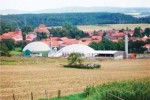
Alternative energy: The methane option
S A Mansoor
06.03.2012- The Financial Express
Except for a mine-mouth coal-fired steam power plant, all our plants are run on natural gas and imported liquid fuel. With gradual shortage of natural gas, and financial and logistic limitations, timely and adequate liquid fuel is not available. We are now facing shortages of electric power for these reasons. The realistic and practical approach to obtain methane gas from human disposable waste, now being totally lost, can provide us an unending supply of Methane gas, which can be used for domestic and industrial purposes.
Given the circumstances, we must go for having alternative sources of fuel and electric power. This should be our most rational option. The authorities should go for it without further debate and any waste of time.
The earlier we start the better for us. The range of the options have to be pragmatic, and the technology, as far as possible, should be simple. This will encourage ready application; with maximum local inputs in terms of materials, equipment and technical inputs.
Among the options, that are available, solar and wind power can provide electricity directly, while solid human sanitary waste can provide us unlimited supply of Methane gas for cooking and heating in the household, commercial or industrial establishments. Some of the realistic options that we can explore are:
(1) Power from waste heat (exhaust gases) from industries and large air conditioning plants, or commercial cooking and heating can provide electricity. However the technology is new and fairly complex which involves semi conductor-based conversion equipment, now starting to be used in some parts of the USA. However, being new, the availability of equipment and expertise is scarce, and naturally expensive. May be, in the next decade, say in 2020, with the shortage of natural fuel, its usage will be more common. We should meanwhile keep track of these developments. When viable and cost-effective applications are established in developed countries, we should adopt those.
(2) Electric power generated by wind turbines, need fairly large open space, and cannot be set up in urban areas, except for very small ones on the roofs of high-rises, which may however need to be structurally designed considering the weight of the unit, plus the dynamic wind loading for storms etc. Further, the capital cost for the wind turbine, which has to be imported, per KW would be possibly the highest. It is proper that the government has taken up wind mapping of possible Bangladesh areas where there is enough wind power potentials. However, for this proposal, the most important disadvantage is that alternative power generation must be kept ready to ensure continuous power supply since wind turbine by itself cannot ensure continuous power supply. Further, servicing and maintenance of this rather complex equipment is now not locally available. It will only be available when a sufficient number of wind turbines are installed. This indicates that at this time, it is only possible to develop wind power through public sector. For example, in Moeshkhali Island which is outside the national power grid and will remain so, may be, for quite some time in future.
(3) Voltaic panels, producing power from the sun’s rays (solar power) is fairly established in Bangladesh. With lack of large open land areas, solar power farms are not possible in Bangladesh. These have been established in desert arias in the USA, Egypt and other countries in the Sahara desert. In isolated rural areas in Bangladesh these are installed as independent direct current (DC) installations, for individual households, and are disconnected from the national grid which is alternating current (AC). In urban areas, it has battery-backed inverter, which converts the DC power to the household AC circuit. The voltaic panel charges the batteries; and when city power is lost, the batteries through the inverter, can supply the household AC circuit. The battery capacity, based on the applied load, determines the time the back-up power can be made available. Its best utilisation is a ready source of emergency electric power for household and commercial applications.
(4) Bio-gas can be a ready source of economic household fuel that can be generated from sewage, processed in bio-digesters. This can save the consumption of finite natural gas that we have, which can be diverted for power generation, for better value addition. Generation of Methane as a bio gas should be the top priority for Bangladesh. The government must take up this programme to have a stable source of methane which is independent of geological or any other limiting factors. The resource is unending so long as there are people in Bangladesh whose bodies provide the raw material for generating methane.
Every toilet is a potential source of methane. However, it is not viable for small households (single-toilet units) where between say four to ten or more members use the toilet. Best are toilets of multiple units, high-rises, or even groups of building having a common and connected sanitary system. Extraction of methane is possible in any residential colony, public buildings, hotels, hospitals, office blocks etc. where large numbers of people use toilets and sufficient human excreta is available as sewage.
The investment cost is low, and the technology is simple. Two bio-digesters are built in parallel, connected to the sewer line, with one in use while the other is cleaned and the sludge is accumulated after all methane gas is released. When the one in use is full, the other one is connected on line, by opening and closing isolating valves. The odourless solid mass of sludge left behind in the filled digester is then removed. The liquid that comes with the sewage overflows away from the top back into the sewage line, while the sewage is deposited in the digester which produces the methane gas. This sludge can be mixed with sawdust, waste wood shavings and other such refuse, mixed with used oils and lubricants and a binder. It is pressed into fuel-cakes in a simple hand press, which is then dried and then used as solid fuel (coal substitute).
In Thailand, which has to import all its fuel, liquid, solid and gaseous, this sewage-based gas (mostly methane) and fuel-cakes have very rapidly caught on as cooking fuel. In Bangkok, large office buildings, police and armed forces barracks, all use this gas and fuel-cakes for cooking. This has spread all over Thailand, and has reduced the import of fuel for domestic use substantially. The fuel cakes are sold from shops selling firewood and coal.
Given this proven background in a neighbouring country, it is not understood why our authorities do not encourage this and provide incentives to urban high-rises, housing colonies, schools and other public buildings to install bio-digesters. This can cut down our use of natural gas for household cooking. Once this is established, the household price of natural gas for domestic use can be made prohibitive, so as to discourage its use in households; which in terms of value addition is not justified.
(5) Fuel cells are now being gradually introduced in the USA and Europe. However, it is still on trial and at limited application stage. It will come into regular and widespread use there possibly in five to seven years at the earliest.
(6) Compressed air driven car should be available within a year or two. Its power source is compressed air tank, instead of the car’s usual fuel tank. Dispensing pumps instead of pumping fuel will pump compressed air into the vehicle tank, from their bulk compressed air tanks, which can be topped up with electric powered compressors running from midnight to four in the morning, when electric power demand is less. First commercial models are coming on the road in France and Germany. India plans to start progressive manufacture of these vehicles in the next few years.
We should encourage the import of these vehicles, may be in the next five years or so, then it will reduce our gasoline and diesel fuel considerably. Our authorities should keep track of this pragmatic and revolutionary vehicle development which could take place around 2020 at the latest. Once we have these non-polluting vehicles on the road, our government should stop the import of fuel-burning vehicles without any delay.
With these pragmatic and known fuel-saving examples before us, it is not understood why our authorities do not publicise these developments, and provide needed financial incentives, so that we can reduce the import of solid and liquid fuel and cut down the consumption of natural gas for household use. This is an area that demands government’s attention on an urgent basis. We should go for the bio-gas source of Methane from human refuse immediately.
The target for Bangladesh should be to maximise the use of these proven alternative sources of power and energy as early as possible. This programme must be implemented with all urgency in our national interest to cut down the import of liquid fuel, a regular drain of our foreign exchange. Reduction of environment pollution will be an additional benefit.
By bringing in the application of these two important innovations, it is believed that we can at least save thirty per cent of our import of liquid fuels and coal as well as substantially cut down our use of natural gas.
The writer is an engineer. He has experiences in both oil and coal-fired power plants.
E-mail: [email protected]









